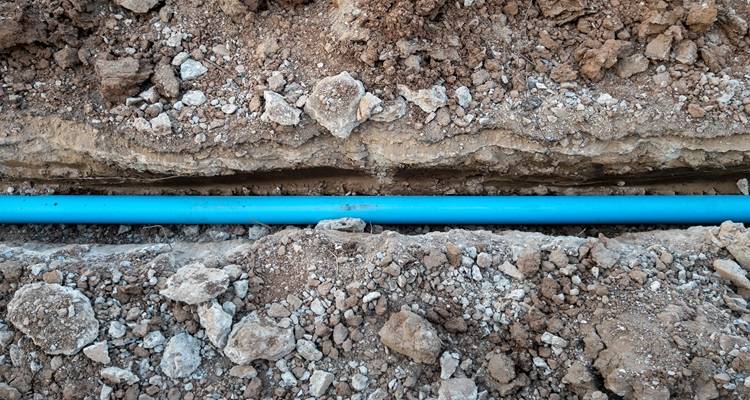Floor Insulation Cost
- The average cost of insulating your floors is around £800
- The job will take approximately 1 - 2 days to complete
- A complete pricing breakdown which includes cost factors to consider, types of floor insulation, along with what such a task usually involves
- How long the job should approximately take and a general overview of what kind of jobs can be performed
- How to find and hire a floor insulation fitter
Do you want to discover how much floor insulation costs?
In this guide, we're going to explore everything you need to know about the costs of installing floor insulation, the different types of floor insulation available and all the costs associated with these types of jobs.
On average, the cost of under floor insulation can typically be anywhere around £800.
Just need a quote?
We have a range of local floor insulation specialists ready to offer you a free quote!
Continue to the complete guide below...
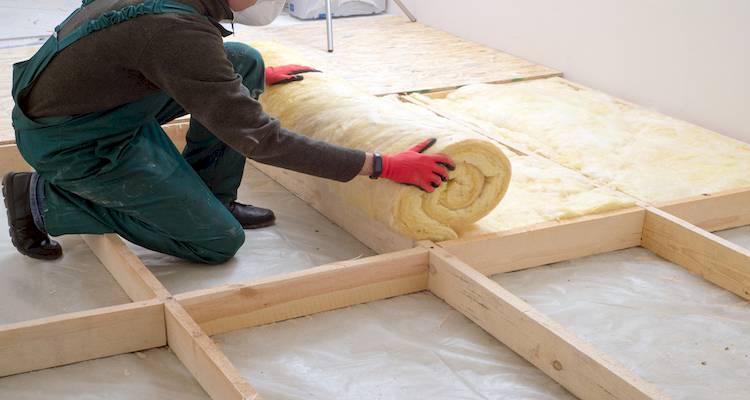
£800
Table of Contents
- How Much Does Floor Insulation Cost?
- Supply Only Costs
- Additional Costs
- Labour Costs and Timescales
- Cost Factors of Insulating a Floor
- What's Involved in Insulating a Floor?
- Can I Insulate a Floor Myself?
- Types of Floor Insulation
- Building Regulations & Planning Permission for Floor Insulation
- Hiring Contractors to Insulate a Floor Checklist
- FAQs
- Sources
How Much Does Floor Insulation Cost?
The cost of floor insulation will depend on a number of factors such as the type of floor that you want to insulate i.e., a concrete floor or a suspended timber floor, the type of insulation used, the size of the floor to be covered and the area that you live in.
Type of Floor
To insulate a concrete floor during construction is relatively easy. You either fit insulation above or below the concrete in the build phase. To retrofit a concrete floor the insulation will need to be fitted above.
Polyisocyanurate, more commonly known as PIR board is popular as a rigid insulation board. It typically comes in a 1.2 metre by 2.4 metre sheet and can be cut to size. The average cost of PIR insulation is around £20-£60 per sheet according to its thickness and rating.
Glass mineral fibre can also be used on concrete floors and a roll can cover approximately six square metres at an average cost of around £25-£30 per roll depending on thickness.
Polystyrene sheets are easily managed and installed underneath or above concrete and provide good thermal resistance. Extruded and expanded polystyrene floor insulation comes in 2.4 metre by 1.2 metre sheets and cost around £15 per square metre.
Suspended floors are floors that are built on floor joists and have a void underneath. These types of floors are excellent candidates for retro-fitting floor insulation and there are many different types that can be used including glass mineral wool, sheep wool, PIR board or loose fill insulation.
Sheep wool insulation for floors is a natural material but has been treated to ensure its longevity. It costs around £18-£25 per square metre.
Loose fill insulation comes in different forms and materials and can be used between the joists in a suspended timber floor. The average cost of loose fill insulation is around £1.50 per kilogram.
Type of Insulation
The different types of insulation available for floors are varied with each having benefits and downsides and this includes the cost with some materials being much more expensive than others.
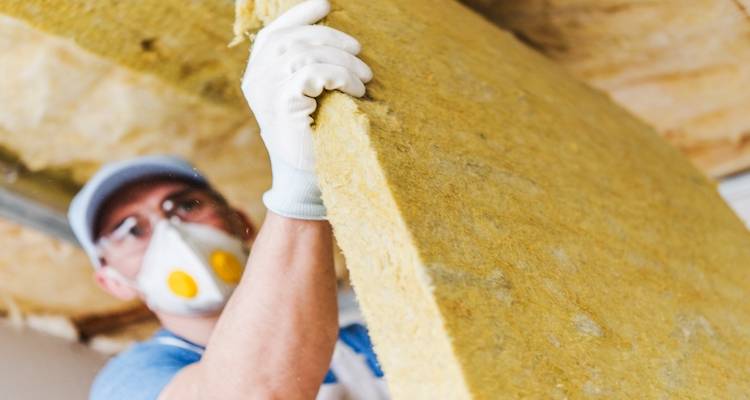
PIR such as Celotex, slab insulation such as Rockwool and expanded polystyrene or extruded polystyrene, are all relatively cheap while some natural insulation such as sheep wool is quite expensive costing around £18-£25 per square metre.
The type of insulation that you install will also vary in the labour costs associated with fitting as some varieties of insulation are easier to install than others.
Size
The area that you want to cover with insulation will have an impact on the floor insulation cost. Most insulation is priced per square metre although some such as loose fill insulation is priced by weight. For this reason, the bigger the area the more you will pay to insulate the floor.
Location
The price that you pay in labour costs will vary according to where in the UK you live with London, the Southeast and other big cities such as Birmingham or Edinburgh being more expensive than other parts of the country.
Ease of Access
Costs may also depend on how easy access to the underneath of the floor will be. Obviously the more work involved in gaining access beneath the floor the higher the labour costs will be.
If there is access from below such as in a basement or cellar then the floor insulation cost may be less as there will be easy access and this should be reflected in the labour costs. If access is difficult and a floor needs to be removed to fit the insulation this too will have an impact on costs.
If I go for a high spec of insulation in my loft conversion, will I need more ventilation?
Floor Insulation Prices
Below are the prices for supply and fitting of different types of floor insulation over 10, 15 and 20 square metres. The table includes insulation used for suspended and concrete floors.
| SUSPENDED FLOOR | 10 SQM FLOOR | 15 SQM FLOOR | 20 SQM FLOOR |
|---|---|---|---|
| Glass mineral wool rolls | £190-£250 | £210-£275 | £380-£500 |
| Glass mineral wool slab | £210-£280 | £240-£320 | £420-£560 |
| Sheep wool | £330-£450 | £420-£575 | £660-£900 |
| Spray on insulation | £350-£700 | £450-£950 | £700-£1,400 |
| Loose fill insulation | £210-£280 | £240-£320 | £420-£560 |
| CONCRETE FLOOR | |||
| PIR board | £220-£400 | £250-£500 | £440-£800 |
| Polystyrene board | £200-£350 | £225-£425 | £400-£700 |
Supply Only Costs
Insulating a floor can typically be done as a DIY task depending on the type of insulation being fitted so you will only need to budget for the supply cost of the required amount of insulation.
However, some floor insulation such as spray on insulation can only be done by a professional with the right equipment and safety clothing.
| INSULATION TYPE | 10 SQM FLOOR | 15 SQM FLOOR | 20 SQM FLOOR |
|---|---|---|---|
| Glass mineral wool rolls | £40-£50 | £60-£75 | £80-£100 |
| Glass mineral wool slab | £60-£80 | £90-£120 | £120-£160 |
| Sheep wool | £180-£250 | £270-£375 | £360-£500 |
| PIR board | £70-£200 | £100-£300 | £140-£400 |
| Polystyrene board | £50-£150 | £75-£225 | £100-£300 |
| Spray on insulation | £200-£500 | £300-£750 | £400-£1000 |
| Loose fill insulation | £60-£80 | £75-£225 | £120-£160 |
Additional Costs
As well as the price of the floor insulation and labour you may also need to budget for some additional costs depending on whether you are fitting the floor insulation in a suspended timber floor or a concrete floor.
Underfloor heating installation is something to consider if you are renovating your floor and installing insulation.
Underfloor heating is popular as there is no need for bulky radiators in the room and it can run at lower temperatures thereby saving energy and money. The average cost of underfloor heating is around £800.
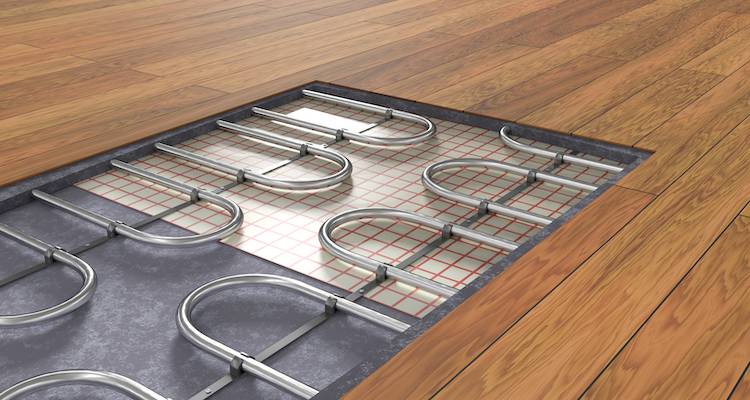
Floorboard repair may be necessary if any of your flooring gets damaged while lifting to install insulation.
Of course, the extent of the repair and whether you do it as a DIY job or hire a professional will dictate the cost. A small repair could be done for around £200 by a professional tradesperson but larger jobs could cost around £500.
If you are installing a new floor or renovating you may need to know the cost to screed a floor. Traditional screed will cost between £12-£15 per square metre while flowing screed can cost between £16-£20 per square metre.
Labour Costs and Timescales
The two most common questions that concern homeowners when planning work in their home is how much it is going to cost and how long will it take. With this in mind there are some considerations to bear in mind when installing under floor insulation.
Labour Cost
The cost of labour for installing underfloor insulation will depend on a variety of factors including, the type of insulation, the size of the floor space to be covered, access to the work, and location of your property.
Most labour costs for this type of installation will be around £150-£200 per day but this can vary according to where you live. London and the southeast area of the UK is typically more expensive for professional contractors due to the higher cost of living. Some other large cities can also be costly in terms of labour charges.
If you hire a company to supply and fit the floor insulation then the cost of labour will be included in the price that you are quoted. You should always request a written quotation rather than accepting a verbal estimate.
Timescales
In any home improvement project one of the most important stages is the preparation. In the case of insulating a floor this may involve clearing a room of furniture and lifting the existing floor covering. This is something you could do yourself or you could hire someone to do it for you.
How long this stage takes will depend on the amount of furniture in the room and the type of floor covering that needs to be removed but 2-4 hours is about an average.
If you are replacing the floor covering then you may get the job done quicker but if you are re-laying the floor covering it pays to take your time and not cause any damage.
Lifting floorboards in a suspended timber floor should also be done with care to prevent damage and the need to replace them. This stage may take 2-3 hours depending on the size of the room and how well the floorboards are fixed in place.
There may be debris beneath the floor which should be removed, and the void cleaned ready to accept the insulation.
Fitting the insulation may take a few hours to a couple of days depending on the kind of insulation and the type of floor you are insulating. Loose fill insulation can be installed relatively quickly so too rolls of glass mineral fibre.
Board insulation such as PIR and polystyrene need to be cut to size so this type will take longer to fit.
What Can Change Labour Costs & Timescales
Each floor insulation project will be unique and have its own considerations and potential issues. However, there are some common problems which can occur. With suspended timber floors you may lift the floorboards and find that the joists are rotten.
This could happen if the airbricks normally fitted on external walls have been removed or covered thereby blocking any airflow and ventilation. Condensation then occurs and eventually the timbers will rot.
If the floor joists are rotten or showing signs of damp then not only will you have to lift and replace them, but you will also need to address the ventilation problem. This can significantly add to both the labour cost and the timescales.
A newly laid concrete floor must be insulated to comply with Building Regulations and if you replace a solid floor in your home it must also comply. However, you can insulate an existing concrete floor by laying insulation boards on top of the concrete and covering with flooring chipboard.
Be aware that this will raise the floor level and you may have to adjust skirting, doors, stairs or electrical sockets. This can substantially add to both the labour costs and the timescales.
Cost Factors of Insulating a Floor
When setting the budget for under floor insulation there are some things you should consider: the type of floor you are insulating, the kind of insulation you are going to use, the size and function of the room concerned, where your property is located and ease of access.
Type of Floor
Depending on whether you want to insulate a suspended timber floor or a concrete floor the costs can vary. While you can use materials such as Celotex floor insulation on both types of floor the work involved to install insulation in each will differ and as such can have a cost implication.
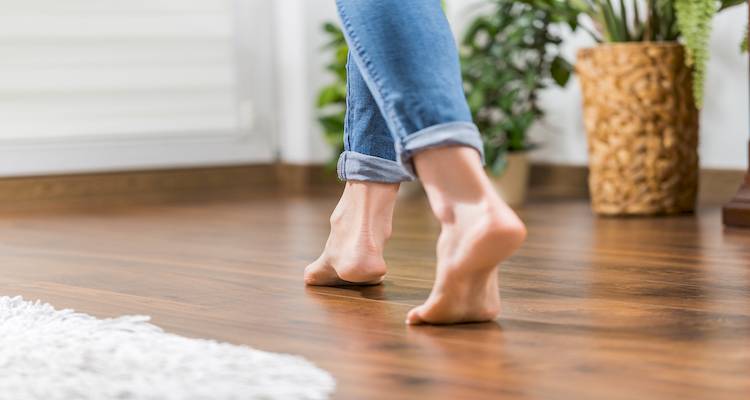
Type of Insulation
Floor insulation varies in type, thermal value and the material it is made from. This has an effect on the price that you will pay for it. Glass mineral wool in rolls or slabs is relatively cheap as is polystyrene board but sheep wool and spray on insulation are both expensive options.
Floor Size
The floor area that you are covering with insulation will have a cost implication. Obviously the larger the area the more floor insulation you will need, and the labour costs will be higher too.
Room Type
Where you are placing your floor insulation can affect the cost of the installation. A room above a garage or basement will benefit from floor insulation and if the joists are visible from the space beneath the insulation can be fitted without the need to lift floorboards.
However, there will be an additional cost as the insulation on the garage or basement ceiling will need to be covered with plasterboard for fire safety. This will add to the overall cost in both materials and labour.
Location of Property
Material and labour costs can vary widely according to the area that you live. The higher cost of living in the capital and other large cities can mean that you will pay more for labour and potentially for the insulation material as well.

Ease of Access
The ease with which the floor insulation can be fitted will be a cost factor. For suspended floor insulation it will generally be necessary to lift the floorboards to access the void underneath. The difficulty level may determine the labour cost according to the amount of work involved.
Concrete floor insulation which is done at the time of construction is straightforward, but a retro-fit can be awkward if the floor level has been raised as a result of the installation. This typically means that doors, skirting and electrical outlets will have to be adjusted to suit the new floor level.
What's Involved in Insulating a Floor?
The process to fit underfloor insulation depends on the type of floor and the kind of insulation used. Solid floor insulation will not typically be fixed in place the same way as suspended floor insulation. While some materials such as floor insulation boards can be used in both types of floor the method of fixing will be different.
Suspended Floors
- Remove the floor covering and lift the floorboards. The floor joists should be checked for damp, rot or other signs of damage.
- If there is exposed clay or soil underneath the floorboards then a vapour barrier should be installed.
- A breathable membrane should be fitted over the joists to form pockets into which the insulation will be laid. This can be held in place by securing battens to the sides of the floor joists.
- Glass mineral wool, sheep wool or loose fill insulation can be fitted between the floor joists. If using Celotex floor insulation or polystyrene floor insulation the membrane is not typically used.
- Once the insulation is in place a vapour barrier can be laid on top and the floorboards replaced.
Concrete Floors
- Insulation can be laid on top of an existing floor but if you are replacing a concrete floor then this is a good time to lay some insulation underneath. In fact, Building Regulations state that you must include or upgrade the insulation in a replacement floor.
- For concrete floor insulation you will need to remove the existing floor covering.
- A damp proof membrane should be laid on top of the concrete.
- Rigid insulation boards such as Celotex floor insulation are then laid on top of the membrane.
- Chipboard flooring or other similar timber sheet material is placed on top of the insulation.
- The floor covering is then re-laid.
- Installing solid floor insulation on an existing floor will raise the entire floor level so adjustments may need to be made to doors, skirting, stairs and possibly electrical outlets.
The cost of insulating a floor made from concrete will depend on whether you insulate during construction, replacement or simply retro-fitting insulation to an existing concrete floor. The amount of labour required, and the type of solid floor insulation used will all have an effect on how much you will pay.
Can I Insulate a Floor Myself?
Installing floor insulation is a relatively simple project for an experienced DIY enthusiast. The work is not complicated nor dangerous although care should always be taken when doing any kind of DIY work in the home. It is also a job that can be done by one person without compromising safety.
Job For Professionals?
While it is possible to fit floor insulation yourself and reduce the cost of insulating a floor the benefits of hiring a professional to do this work should not be overlooked. While the job may be quite straightforward there is no substitute for experience and professional knowledge.
There is also the guarantee on the work to be considered which you will not have if you do the work yourself. For a replacement floor which is required to comply with Building Regulations for installation of insulation you will need to ensure that you are meeting those standards.
As a DIYer you will not be able to sign off on the work yourself if you are replacing a floor and fitting insulation. However, if you are simply installing floor insulation boards or mineral wool to an existing floor then this is not notifiable works and you do not need to inform Building Control or get the work inspected.
Only if you are replacing the floor will it need to be signed off once the insulation is installed.
Which Jobs Can Be Done DIY?
If you hire a professional contractor to install floor insulation there are some jobs which you can do yourself to reduce the cost of insulating a floor. You can clear the room and remove the existing floor covering. Quite often the void underneath a suspended timber floor will contain debris and you can clear this out in preparation for the insulation work.
DIY Dangers & Risks
Although the process of insulating a floor is relatively straightforward there are some risks and hazards associated with the work. It is important when working with insulation to wear a dust mask and gloves as some materials such as glass mineral wool can be an irritant to airways and skin.
Types of Floor Insulation
There are many different types of insulation for floors, coming in different forms and made from various materials. Each has benefits and drawbacks, so it is important to ensure the type you choose is the best to insulate your particular floor.
Glass Mineral Wool Rolls Cost
The structure of glass mineral wool prevents the movement of air making it a very effective means of insulating your floor. It is a mat of fibres which contains recycled glass and contributes to heat retention and noise reduction when used as floor insulation.
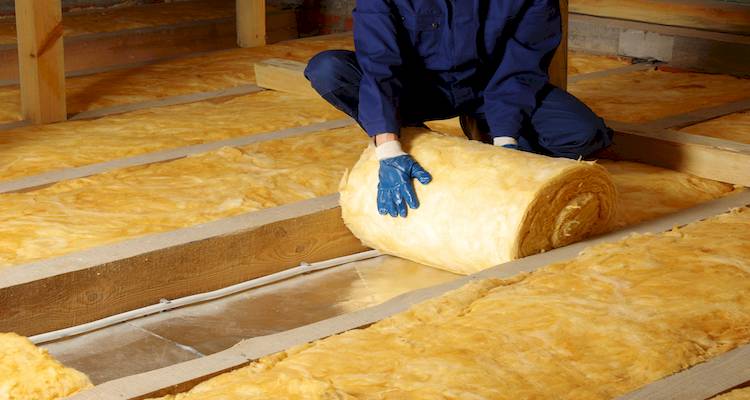
The product in rolls is easy to use and roll out between floor joists and is more easily manipulated into place.
The average cost of glass mineral wool is £4-£5 per square metre depending on thickness and make.
PROS
- ✔ Relatively cheap
- ✔ Easily handled and installed
- ✔ Excellent insulating and sound proofing qualities
CONS
- ✖ Can be a skin and lung irritant so safety clothing should be worn during fitting
- ✖ It cannot completely seal all gaps in the floor
- ✖ If it gets wet it will lose its effectiveness
Glass Mineral Wool Slab Cost
Glass mineral wool slabs are made from the same material but come in rigid or semi-rigid panels rather than in rolls. They can be friction fitted which means they will be tight against the sides of the floor joists. The slabs are easy to handle and can be cut to size with a hand saw.
The average cost of glass mineral wool slabs is £6-£8 per square metre.
Pros
- ✔ Excellent insulating and acoustic qualities
- ✔ Easy to manipulate and cut to size
- ✔ Comes in a range of sizes to minimize waste
CONS
- ✖ The material can be a skin and lung irritant
- ✖ Slabs can compress and sag over time
- ✖ If there is insufficient ventilation beneath the floor the slabs can cause condensation and damp
Sheep Wool Cost
People have been using sheep wool to insulate their homes for centuries. However today the wool is combined with polyester to provide a more workable material.
It is a flexible soft material to lay and even when wet will retain its insulating properties unlike glass mineral wool.
The average cost of sheep wool insulation is £18-£25 per square metre.
Pros
- ✔ An ecologically friendly product
- ✔ Natural insulating properties
- ✔ Does not contain harmful or irritating fibres
Cons
- ✖ Sheep wool needs to be treated to reduce the risk of fungal growth or insect infestation
- ✖ Expensive compared to other types of floor insulation
- ✖ The U value of sheep wool is higher than glass mineral wool which means it is not as insulating as glass mineral wool
PIR Board Cost
PIR board is a core of polyisocyanurate between two layers of high performance aluminium foil facings. There are many brands such as Celotex and Kingspan and it is used as a concrete floor insulation as well as in suspended timber floors.
These floor insulation boards can be easily cut to size and friction fitted between floor joists.
The average cost of PIR board is between £7-£20 per square metre.
Pros
- ✔ Lightweight and easy to handle
- ✔ Can be cut to any size or shape
- ✔ Will not sag or compress over time
Cons
- ✖ The lower the U value you want to achieve the thicker the board needs to be
- ✖ When retro-fitted PIR boards will raise the floor level meaning adjustments will need to be made to doors, skirting, stairs, and electrical outlets.
- ✖ The cost of PIR insulation has risen considerably in recent years
Polystyrene Board Insulation Cost
Expanded polystyrene (EPS) board is a versatile material that has been used for decades in many different ways. It is commonly seen as packaging but has been used as insulation for over 20 years.
EPS is inert, non-toxic and rot proof. The boards are made from polystyrene beads which are bonded together when heated.
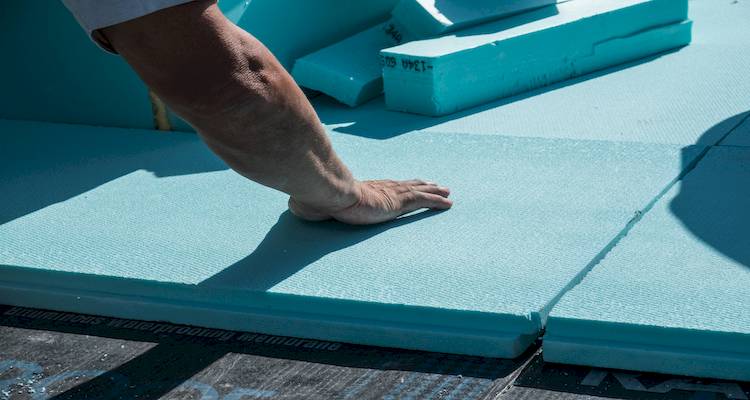
The average cost of polystyrene floor insulation is £5-£15 depending on thickness and manufacturer.
Pros
- ✔ Very lightweight so easy to handle and cut to size
- ✔ Excellent insulating properties
- ✔ Does not absorb water so will retain insulating performance
Cons
- ✖ Lower required U values will need thicker boards
- ✖ On existing concrete floors, the polystyrene boards will raise the floor level meaning additional work and costs for adjustments to doors, stairs, or electrical sockets
- ✖ Can be easily damaged
Spray-on Insulation Cost
Open cell spray-on insulation creates an insulating barrier while still allowing the building to breathe. This means that although the insulation will reduce air movement it will not trap moisture which can cause floor joists to rot.
Many spray-on insulations will remain flexible and soft after application which will allow it to expand and contract with the building without breaking or cracking.
The average cost of spray-on insulation is £35-£70 per square metre.
Pros
- ✔ Open cell spray-on insulation remains breathable while providing an air barrier
- ✔ Will fill all parts of the void beneath the floor including around pipework
- ✔ Remains soft and flexible allowing movement with the building
Cons
- ✖ One of the most expensive types of insulation
- ✖ Looks untidy
- ✖ Needs to be installed by a licenced contractor
Loose Fill Insulation Cost
Loose fill insulation can be made from a range of materials such as old newspaper, cork or similar materials which are combined with a fire retardant material. It is suitable for awkward areas that are difficult to fit solid insulation in.
The average cost of loose fill insulation is £6-£8 per square metre.
Pros
- ✔ Easily installed in awkward to reach or odd shaped areas
- ✔ Relatively cheap
- ✔ Contains no irritants to harm skin or lungs
Cons
- ✖ Can be displaced by draughts
- ✖ Will settle over time and need to be topped up
- ✖ Will not hold insulating properties if it gets wet
Building Regulations & Planning Permission for Floor Insulation
Before commencing any construction or significant home improvements in your property you should check if you need to comply with any Building Regulations and if you need planning permission.
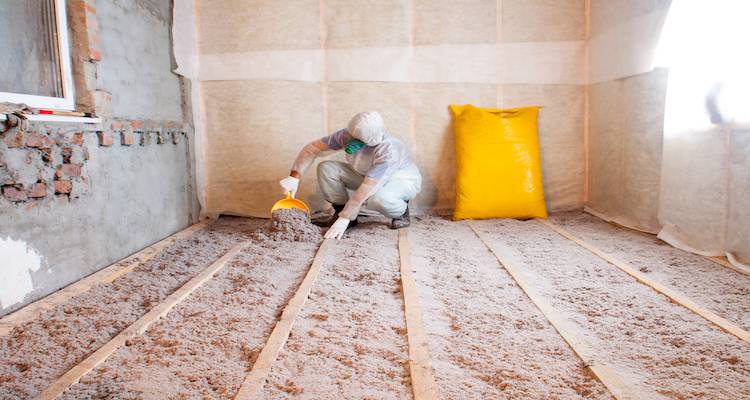
Building Regulations
If you are replacing an existing floor that does not currently have insulation then the new floor and its insulation need to comply with Approved Document L of the Building Regulations. The same is true if you are replacing more than 25% of a solid or suspended floor.
The new insulation must meet the minimum energy efficiency values set out in the Approved Documents.
If you are unsure about which Building Regulations apply to the work you are doing you can consult the government website for clarification.
The work is not notifiable unless it falls under the remit of a larger program of work in the property such as a complete renovation. In this case you will probably have a professional contractor doing the work who can self-certify.
If you are doing it as a DIY renovation then you will need a building inspector to come and sign off the insulation. Inspection fees vary between different councils so you will need to contact the building control department of your local authority and discuss it with them.
Planning Permission
It is not normally necessary to obtain planning permission to fit insulation in your home. For further information you can contact the building control department of your local authority or check the Planning Portal.
Hiring Contractors to Insulate a Floor Checklist
Before hiring a contractor to carry out work in your home you should make a checklist of questions to ask. The following is not an exhaustive list but should give you an idea of the kind of things you need to ask a potential contractor.
Qualifications
There are contractors who specialise in fitting insulation, but most general builders are capable of installing floor insulation. There are no specific qualifications needed to fit floor insulation, but a specialist or builder should have the necessary knowledge and expertise to do the job properly.
Experience
When hiring contractors one of the most important considerations is the amount of experience they have had in the particular work that you wish to have done. In this case you will want to know how much experience the contractor has in fitting floor insulation and their knowledge of the different types of insulation available so they can best advise you.
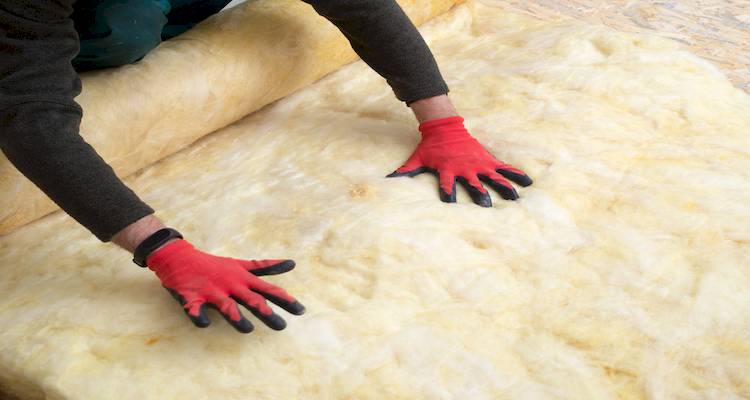
Previous Work
While some improvement works can be viewed after completion it may be difficult for you to see previous floor insulation work done by contractors you are considering. However most established companies have up to date websites, and most will show previous completed projects.
Previous Customers Rating
If you cannot see completed work done by the contractors you are considering hiring then it may be possible to get feedback from previous customers. This may be either through reviews online or personal recommendation.
Accreditation
For specialist insulation contractors you can enquire if they are members of the National Insulation Association (NIA). The NIA represents the insulation industry in the UK and consists of manufacturers, system designers and installers. Their purpose is to maintain and raise standards in the insulation industry.
Other accreditations to look out for are Trustmark or the Cavity Insulation Guarantee Agency (CIGA).
FAQs
What is the best insulation for a concrete floor?
How does floor insulation work?
Is it worth insulating floors?
Can installing floor insulation create condensation and damp problems?
If this is covered or blocked after installing floor insulation the lack of air flow and heat producing insulation will combine to create condensation and over time may cause the floor joists to rot. The condensation may also affect the performance of some insulation such as glass mineral wool.
How effective is floor insulation?
Sources
https://www.insulationsuperstore.co.uk/help-and-advice/project-guides/insulation/insulating-a-floor/
https://www.eco-home-essentials.co.uk/underfloor-insulation.html
https://energysavingtrust.org.uk/advice/floor-insulation/
https://www.designingbuildings.co.uk/wiki/Floor_insulation
https://www.ecomerchant.co.uk/thermofloc-loose-fill-cellulose-insulation-12kg.html
https://www.cse.org.uk/advice/advice-and-support/underfloor-insulation
https://greenhorizonenergy.co.uk/underfloor-insulation/
https://www.planningportal.co.uk/info/200130/common_projects/32/insulation/6






